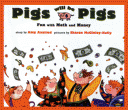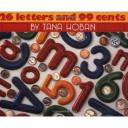Teachers can use the following resources for students that are in the first grade who are learning about money with a total value up to 100 cents or less (Virginia Standards of Learning for 1.7 a & b).
Text Annotations:
The Coin Counting Book written by Rozanne Lanczak Williams is a fun rhyming book for students to learn about counting money and it’s value. The book introduces pennies, nickels, dimes, quarters as a way for students to do simple math with rhyme:
“Let’s count our five pennies just one more time. If we add five more pennies we’ll have…one dime.”
Actual size coins are spread out over the pages showing both front and back for student learning. If the book says to count five pennies as an example, there are five pennies laid out on the page with a addition sign in between each coin to help with student visualization. The book ends by showing a hand placing coins in a piggy bank making the statement: “If we save some of it- the rest we can spend!”
Pigs will be Pigs, Fun with Math and Money written by Amy Axelrod and illustrated by Sharon McGinley-Nally is about a family of hungry pigs looking for money in their house so they can go to their favorite place to eat a snack. This is a great book for introducing students in the first grade to money. The pig family is hungry and realize they do not have enough money to go out to eat; so Mrs. Pig decides that everyone will “Hunt for Money!”. The book describes where in the house and how much money everyone in the family finds while on the money hunt. In the end, the Pigs have enough money to eat out and when they arrive home they find their house in a mess from their hunt. Pigs will always be pigs.
The book, 26 Letters and 99 Cents written by Tana Hoban provides photos of numbers from 1-30, counting by 5’s from 30-90 and 99. Beside of each number there is a photo of coins that shows the value of the number when added. The book can be shown to the whole class while identifying each coin and the value. This would also be a great book for students to look at during the day as a center activity, etc. The book shows students both the front and back of real American coins: pennies, nickels, dimes and quarters in their actual size. This helps students to visualize the size and identification of each coin.
The book If You Made A Million written by David M. Schwartz and illustrated by Steven Kellogg is a book where students can really use their imagination. Readers are given different scenarios with spending anything from one penny to purchase a peeble all the way up to one million dollars with the option of saving the money at the bank. This would be a great way to ask students for ideas about what they would purchase with different amounts of money. Schwartz gives differnet forms of measurement for various amounts of money. For example, one hundred dollars in pennies stacked up would be equal to fifty feet or a million dollars in quarters would equal a whale’s weight. This is a great book to help students realize that a paper bill is sometimes easier (and lighter) to carry around instead of coins.
The last text would be a great resource for students who are in need of a more challenging way to think about money and its uses. Money Madness written by David A. Adler and illustrated by Edward Miller explains how money first originated and how money is now used to purchase different items from around the world. The book starts off by asking:
“What’s all this money madness? People talk about money and work for it. They seem to always want more of it…”
The book gives examples of why people now use money to purchase a variety of items. If people did not have money then they would have to make their own bread. Adler explains at a child’s level how people first started to trade by introducing the word, barter. An example that Adler used was when a person would trade an animal in exchange for berries. Even though the person receiving the berries might not want them he knew that someone else would want to trade the berries for something that he wanted or needed in return. The book explains how rocks were used as an early form of money and then replaced by metals (silver and gold). The silver and gold pieces were made into coins but were at times difficult to carry if someone had a lot. Paper money was then invented. Adler explains how each country has it’s own form of money and that the value of the money can vary from place to place. “You know with money you can buy things you want. With money you can buy things you need.”
Web Annotations:
Students can play the game Change It for additional practice on adding up different coin values. Teachers can create each game to specifically fit each students instructional level.
GPB Kids has created a web-site for students to play a game where they are given nine different items that they need to buy. Players are instructed to buy one of the nine items by dragging the correct coin(s) to the matching picture in the chart. If the player is right then they can move on to the next problem; if not, they have the chance to try again.
Teachers can create different tutorials for students by selecting any combination of pennies, nickels, dimes and quarters for practice. For each category chosen, students are provided a picture of real money on the left side of the screen and need to select the correct value of the money from the right side of the screen. If the student selects the correct amount of money they can move on to the next problem. If an incorrect answer is chosen, then the student can try again.
HMH School Publishers created a great money practice tool for students. For the activity, coins are lined up in decreasing value from largest to smallest. Students need to count the value of the coins and type the correct amount of money in the blank provided. Students then need to click on “check” to see if they have typed in the correct amount. If so, the student will hear chimes, if an incorrect amount is typed in then the student will see a screen flash up that explains the amount is either greater or less than the answer that was entered.
Kid 20/20 has an activity, Coin Sort that students can play on-line. Students are given 280 seconds to properly place different coins in the corresponding piggy bank. Each piggy bank is labeled with either pennies, nickels or dimes on the side. Students must click on each coin and drag it to the proper piggy bank. If the coin is taken to the correct piggy bank then the coin will disappear and the value of the coin will be added to the amount already in the piggy bank. Students can visually watch as the amount increases by either one, five or ten cents.
Additional Resources:
The United States Mint has a great web-site that teachers can use for various reasons. The site contains ideas for lesson plans, coin programs which give detailed information about each coin and coin curricula. Teachers can also use the site for class activities: game centers, web gadgets (worksheets), learning centers (ways to bring in different areas of the curriculum and financial literacy).
Scholastic has a great web-site for teachers. Teachers can download different activities from worksheets, foldables, mini-books, and even lesson plans. Click on “Teachers Resources” and select lesson plans, printables or mini-books. Narrow each search by selecting 1st grade, math and then money from each category on the left hand side of the screen. *This web-site requires a yearly paid subscription.*
Teaching Money Skills by Grade Level: First Grade is an article that teachers can read prior to teaching first grade students about money. The article provides a review and instructional method for teaching a lesson or unit on money. The article recommends that teachers use play/fake money with their students for a hands-on learning experience. After the unit lesson on money, students should be prepared for second grade math: addition and subtraction of money.





